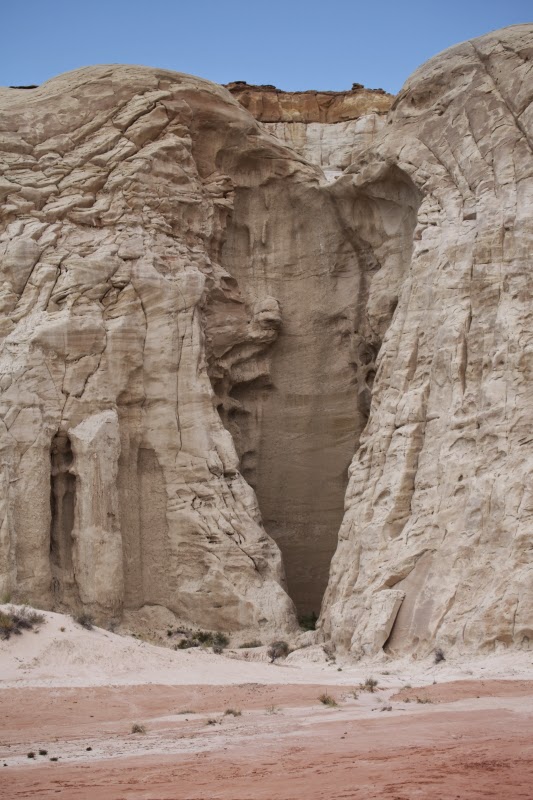In late April I took nine enthusiastic Venturers to the Grand Staircase-Escalante National Monument in southern Utah. The area is astounding and contains colorful and interesting rock formations, many Native sites, a few streams and waterfalls, and more scenery than one can possible assimilate in one week.
Our group beginning our first big hike at Lower Calf Creek Falls
These three guardians can be seen by observant hikers along the way in
After nearly 3 miles of walking, the falls come into view
They are truly unique in GS-ENM and even the whole Colorado Plateau. The water very likely originates as snow on the top of Boulder Mountain (Aquarius Plateau), making its way in the aquifer to the springs that feed Calf Creek.
Another shot of the group in front of the falls
The falls descend through the Navajo Sandstone, relatively resistant to erosion thus forming a constriction along the stream. Once the creek "falls" through to the Kayenta Formation, which is softer and more easily eroded than the Navajo Ss., the canyon widens up. This view looks upstream on Calf Creek at the point where the change in the canyon's width occurs. The Navajo is generally white here and the Kayenta is more reddish and interbedded with sandstone and siltstone.
A juniper relic from one of the previous droughts in the southwest
This is the 100 Hands panel above the Escalante River near Calf Creek
Looking upstream from the confluence of Calf Creek and the Escalante River
A petroglyph panel along the Escalante River
Day 3 saw our group down on the Hole-In-The-Rock Road and wandering down into the Dry Fork of Coyote Gulch
These narrow passages are fairly young features on the landscape, thus their youthful (narrow) character
Down to the bedrock bottom of the Gulch
Within the walls of the Dry Fork are excellent examples of the cross-bedding in the Navajo Sandstone. We observed textures related to sand avalanches (when the ancient dunes became over-steepened and sloughed down the leeward side) and climbing translatent strata (textures left by wind ripples across the leeward side of the dune). Additionally, we saw these iron concretions in the sandstone where extra iron precipitated out from fluids to make spheres of hardened sandstone. When dislodged from the cliff, they become "Moki marbles."
Virga occurs when rain evaporates before reaching the ground
The Straight Cliffs along the Hole-In-The-Rock Road form one of the most beautiful escarpments in the whole Southwest
A delicate arch form in the Devil's Garden section of the Monument is carved in Entrada Sandstone. This is the same rock unit that holds the arches in Arches National Park farther east.
The Devil's Garden
Another group shot near the rocks
We were lucky to have so many wonderful clouds to frame our sky this time of the year. Spring is normally dry in this part of the world.
We also made a stop at the new Escalante Heritage Center on the outskirts of Escalante town. Here is a replica of the wagons used in the Hole-In-The-Rock expedition.
On day 4 we headed east along the Burr Trail and found a narrow slot canyon beautifully back-lit Box elder trees (the state tree of Utah)
Into the slot
What a precious place, this one cut into the Wingate Sandstone
Next up was a short hike to the Wolverine Petrified Wood Area (south of the Burr Trail). While not as colorful as the petrified wood in the national park in Arizona, the area is rich in giant logs with great preservation.
In some specimens, knots can be seen where branches grew out of the trees
The switchbacks on the Burr Trail are exciting. We hiked along the road while two volunteers brought our vehicles down the twisting road, originally built in the 1950's as a uranium haul road from the Circle Cliffs to the mill's farther south.
Looking up at the dip on the Waterpocket Fold. The contact is the same as seen in Calf Creek with the reddish Kayenta lying below the white Navajo Sandstone.
Once below the fold, we could look up and see how the strata are being stripped off it. Reddish Carmel Formation form flat-irons against the underlying Navajo Sandstone.
Sign at the trail-head for the Strike Valley Overlook, one of my favorite places in the whole Southwest
On the way in we saw a huge juniper tree that had obviously been hit by lightning. No other trees were burned and it was splayed open and burned from the center outwards.
The enjoyable walk up....
...yields this reward! The Strike Valley in Capitol Reef National Park.
Looking south along the Waterpocket Fold
Looking north along the fold
The more resistant units stick up out of the valley while the softer units are covered by alluvium in the valley floors
Way in the distance, the Henry Mountains laccolith have punched through the sedimentary rocks. Note the Navajo Sandstone upturned along the edge of the intrusion. To see pictures from the contact up close, look at my blog posting here.
I just could not stop taking pictures on this picture perfect day!
On the return to Flagstaff, we stopped in the Monument at a place called the Toadstools
This is Entrada Sandstone with loose boulders of the Dakota Sandstone serving as the cap rock
Heart rock in the Entrada Sandstone
A family of hoodoos. These can tell us how fast the floor of the valley is "deflating." They began as rockfalls onto the valley floor and have protected the softer rocks below to create pedestals. And if we could know the rate at which the softer rock erodes, we could know when the rockfall occurred.
A great ending to a great trip
Yucca in bloom. My trip next year is already scheduled - April 25 to 29. Join me!












































No comments:
Post a Comment
If your comment will not post, email me with the problem.